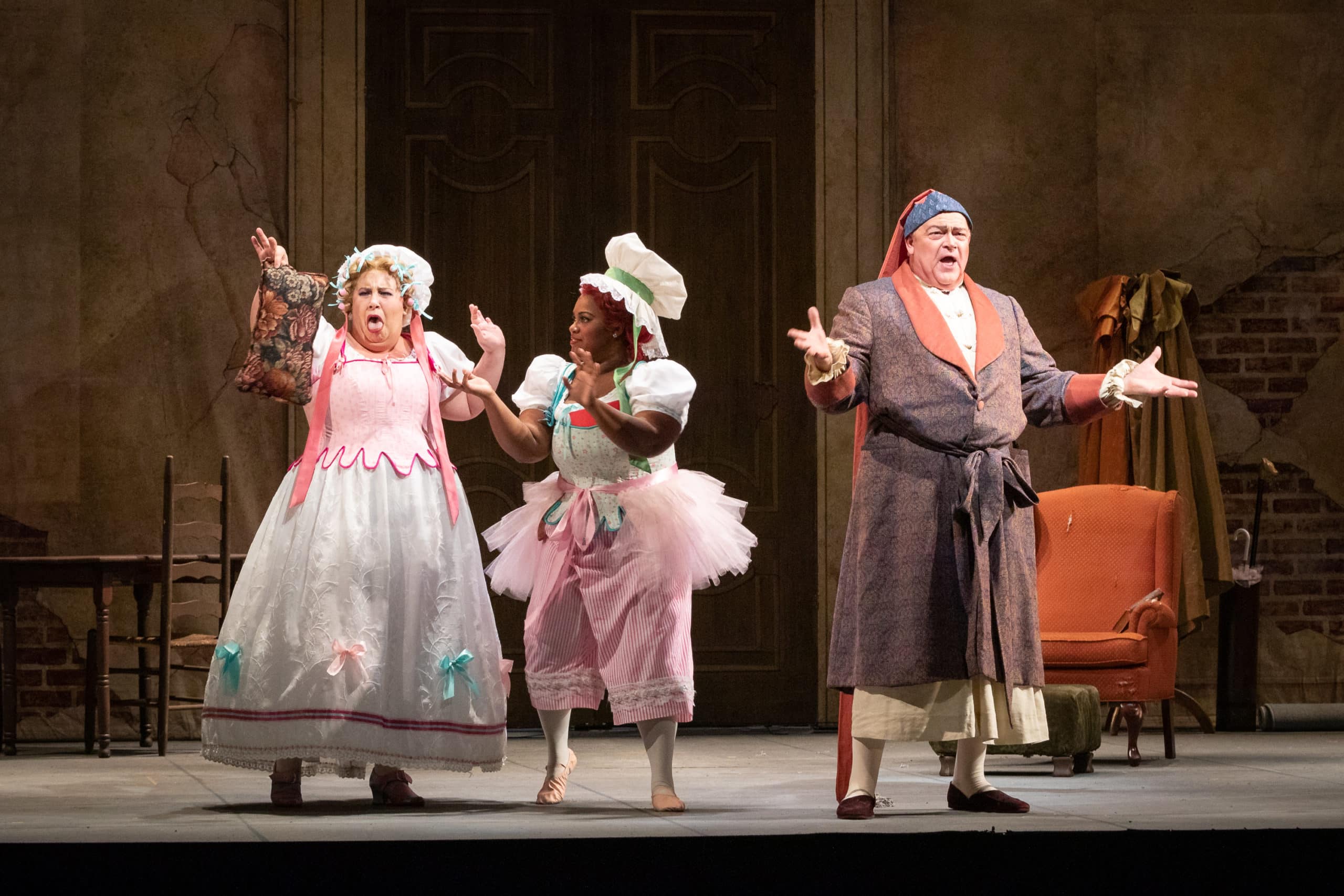Spoiler alert: Cinderella and the Prince live happily ever after. Of course, since Virginia Opera, like all opera companies of any size, prints a detailed synopsis in the program each patron receives, the very notion of spoilers is largely irrelevant in the opera world.

But Gioachino Rossini’s 1817 comic telling of the famous story (libretto by Jacapo Ferretti) does have a few pleasant surprises for those familiar with other versions. Forget fairy godmothers, evil stepmothers, glass slippers and midnight deadlines, let alone mice who pull pumpkin carriages. What matters here is less plot devices than opportunities for the singers to display their skills in the individual melodies and intricate ensembles the composer gives them.
In the bel canto opera style, of which Rossini, along with his contemporaries Donizetti and Bellini are the most famous practitioners, vocal virtuosity is primary. Extensive use of coloratura trills and ornamentation are important in the style, and Virginia Opera’s cast handled the music’s requirements in fine fashion.
Soprano Alyssa Martin played Angelina, the Cinderella character, more often cast with a mezzo. While a few of the role’s lower reaches seemed a bit of a stretch, Martin’s singing and acting effectively conveyed the essential sweetness of the character, such as in her opening dream of royalty loving a common girl and closing song of peace and forgiveness.
Her prince, Don Ramiro, lyric tenor David Walton, provided graceful vocal lines in his initial duet with Cinderella as well as strength and determination in his singing as he seeks his love and reproves her dysfunctional family. As princes go, Walton’s Ramiro is a genuinely nice guy, unpretentious, lacking in arrogance, who sees the hearts of people rather than their surfaces.
Dandini, played by Joseph Lattanzi, is much more than Ramiro’s valet. He is his buddy and sidekick, a contented second fiddle. As portrayed in this production, the relationship is rather like that between Donald O’Connor and Gene Kelly in Singing in the Rain. With a relaxed demeanor and a seemingly effortless baritone delivery, Latzanni stands out in a role that might be overlooked in some productions. He and Walton were delightful scene partners as they switched identities in the first act.

Then there’s the dark side, led by Cinderella’s pompous buffoon of a stepfather, Don Magnifico, bass-baritone Dale Travis. With the most commanding voice in the cast, Travis was particularly effective in the rapid-fire verbal material given the character, which would make a Gilbert and Sullivan patter song character green with envy. Travis also captured the over-the-top foolishness of the character. Magnifico is not someone who catches on quickly, a good deal of his comedy stemming from his extreme cluelessness.
Magnifico’s mean girl daughters, Clorinda (soprano Symone Harcum) and Tisbe (mezzo Whitney Robinson), generate laughs through their unawareness of the ridiculous nature of their pursuit of the prince. Many of their best vocal moments occur in the numerous small ensemble numbers that are a principal decoration of Rossini’s score.
Bass-baritone Karl Buttermann brings an upright military bearing to his role as Alidoro, Ramiro’s tutor, a figure of wisdom who cleverly arranges the scenario that brings the lovers together and thwarts the plans of Magnifco and his daughters.
Adam Turner’s direction of the orchestra kept the pace appropriate to each part of the score and maintained a good balance with the singers, noticeable particularly in its accompaniment of Cinderella’s quiet moments. The all-male chorus sang well in its limited time on stage.
Director Kyle Lang’s staging of the opera had two contrasting aspects. Many moments involved detailed, coordinated movements of cast members, often timed down to the level of individual notes. Then there were ensemble numbers that were basically stand-and-sing pieces. Both worked, but the difference was striking at times. Lang’s funniest moment came at the end of the first act, a frenetic game of musical chairs ending in comic disaster.
Tony Fanning’s sets – especially Don Magnifico’s rather decrepit house, with stucco peeling off the brick – were well-executed. There was the sometimes awkward use of a drop made to look like an oversized patchwork quilt, lowered occasionally as cast members played a front-of-curtain scene while sets were changed behind it. Sue Bonde’s costumes were a highlight, including the red and later black livery of Ramiro’s retinue, the prince’s blue uniform, the clownish outfits (such as a pink tutu) for Magnifico’s daughters, a cloak filled with documents that made a character look like a walking bureaucracy at one point, and Cinderella’s sparkly blue ball gown. The overall physical production was good to look at and suitable for the period and action.
The only technical downside was Driscoll Otto’s lighting design, or perhaps its execution, which was consistently distracting and seemingly arbitrary, often leaving soloists in cold spots as they sang (Ramiro was a particular victim of this tendency) while illuminating singers that were not directly involved at the moment. The production’s surtitles operated only intermittently.
With its emphasis on human kindness and the power of forgiveness, and its lack of reliance on magic and special effects, this is one of the most satisfying versions of the Cinderella story. The melodic beauty and complexity of Rossini’s score, well conveyed by Virginia Opera’s cast, created an excellent experience for the audience.
Virginia Opera’s production of Cinderella concluded its Fairfax run at George Mason University on February 16, 2020. The show next plays in Richmond, Virginia on February 21 and 23, 2020.





It is common practice in opera to stop putting surtitles up if there is repeated text in the libretto. Particularly in bel canto, it is sometimes even the preference of the director to stop repeating the surtitles so that attention can be paid to the action onstage without worrying about looking up at the titles. As someone who is intimately familiar with the translation of this show, I can assure you that all of the text of the libretto was represented in the titles, even if they were not constantly running on the screen above the stage.